1. Which feature on a Cisco router permits the forwarding of traffic for which there is no specific route?
- next-hop
- gateway of last resort
- route source
- outgoing interface
2. Which three advantages are provided by static routing? (Choose three.)
- Static routing does not advertise over the network, thus providing better security.
- Configuration of static routes is error-free.
- Static routes scale well as the network grows.
- Static routing typically uses less network bandwidth and fewer CPU operations than dynamic routing does.
- The path a static route uses to send data is known.
- No intervention is required to maintain changing route information.
3. What are two functions of dynamic routing protocols? (Choose two.)
- to maintain routing tables
- to assure low router overhead
- to avoid exposing network information
- to discover the network
- to choose the path that is specified by the administrator
4. What is an advantage of using dynamic routing protocols instead of static routing?
- easier to implement
- more secure in controlling routing updates
- fewer router resource overhead requirements
- ability to actively search for new routes if the current path becomes unavailable
5. What happens to a static route entry in a routing table when the outgoing interface associated with that route goes into the down state?
- The static route is removed from the routing table.
- The router polls neighbors for a replacement route.
- The router automatically redirects the static route to use another interface.
- The static route remains in the table because it was defined as static.
6. What is a characteristic of a static route that matches all packets?
- It uses a single network address to send multiple static routes to one destination address.
- It identifies the gateway IP address to which the router sends all IP packets for which it does not have a learned or static route.
- It backs up a route already discovered by a dynamic routing protocol.
- It is configured with a higher administrative distance than the original dynamic routing protocol has.
7. When would it be more beneficial to use a dynamic routing protocol instead of static routing?
- in an organization where routers suffer from performance issues
- on a stub network that has a single exit point
- in an organization with a smaller network that is not expected to grow in size
- on a network where there is a lot of topology changes
8. Which route would be used to forward a packet with a source IP address of 192.168.10.1 and a destination IP address of 10.1.1.1?
- C 192.168.10.0/30 is directly connected, GigabitEthernet0/1
- O 10.1.1.0/24 [110/65] via 192.168.200.2, 00:01:20, Serial0/1/0
- S* 0.0.0.0/0 [1/0] via 172.16.1.1
- S 10.1.0.0/16 is directly connected, GigabitEthernet0/0
9. Refer to the exhibit. What is the administrative distance value of the route for router R1 to reach the destination IPv6 address of 2001:DB8:CAFE:4::A?
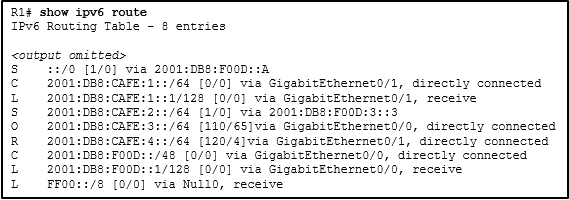
- 120
- 110
- 1
- 4
10. Which value in a routing table represents trustworthiness and is used by the router to determine which route to install into the routing table when there are multiple routes toward the same destination?
- administrative distance
- metric
- outgoing interface
- routing protocol
12. Refer to the graphic. Which command would be used on router A to configure a static route to direct traffic from LAN A that is destined for LAN C?
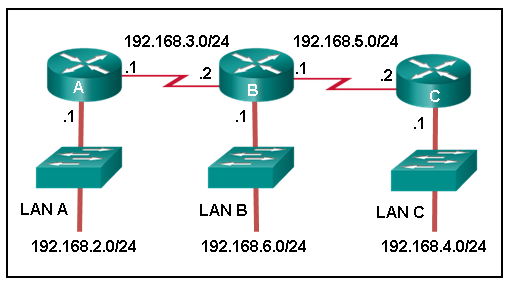
- A(config)# ip route 192.168.3.0 255.255.255.0 192.168.3.1
- A(config)# ip route 192.168.3.2 255.255.255.0 192.168.4.0
- A(config)# ip route 192.168.4.0 255.255.255.0 192.168.5.2
- A(config)# ip route 192.168.5.0 255.255.255.0 192.168.3.2
- A(config)# ip route 192.168.4.0 255.255.255.0 192.168.3.2
13. On which two routers would a default static route be configured? (Choose two.)
- any router where a backup route to dynamic routing is needed for reliability
- the router that serves as the gateway of last resort
- any router running an IOS prior to 12.0
- stub router connection to the rest of the corporate or campus network
- edge router connection to the ISP
14. Refer to the exhibit. This network has two connections to the ISP, one via router C and one via router B. The serial link between router A and router C supports EIGRP and is the primary link to the Internet. If the primary link fails, the administrator needs a floating static route that avoids recursive route lookups and any potential next-hop issues caused by the multiaccess nature of the Ethernet segment with router B. What should the administrator configure?

- Create a static route pointing to 10.1.1.1 with an AD of 95.
- Create a fully specified static route pointing to Fa0/0 with an AD of 1.
- Create a fully specified static route pointing to Fa0/0 with an AD of 95.
- Create a static route pointing to 10.1.1.1 with an AD of 1.
- Create a static route pointing to Fa0/0 with an AD of 1.
15. What is a characteristic of a floating static route?
- When it is configured, it creates a gateway of last resort.
- It is used to provide load balancing between static routes.
- It is simply a static route with 0.0.0.0/0 as the destination IPv4 address.
- It is configured with a higher administrative distance than the original dynamic routing protocol has.
16. What network prefix and prefix-length combination is used to create a default static route that will match any IPv6 destination?
- FFFF::/128
- ::1/64
- ::/128
- ::/0
17. Consider the following command:
ip route 192.168.10.0 255.255.255.0 10.10.10.2 5
What does the 5 at the end of the command signify?
- exit interface
- maximum number of hops to the 192.168.10.0/24 network
- metric
- administrative distance
18. Refer to the exhibit. The routing table for R2 is as follows:
Gateway of last resort is not set
10.0.0.0/30 is subnetted, 2 subnets
C 10.0.0.0 is directly connected, Serial0/0/0
C 10.0.0.4 is directly connected, Serial0/0/1
192.168.10.0/26 is subnetted, 3 subnets
S 192.168.10.0 is directly connected, Serial0/0/0
C 192.168.10.64 is directly connected, FastEthernet0/0
S 192.168.10.128 [1/0] via 10.0.0.6
What will router R2 do with a packet destined for 192.168.10.129?
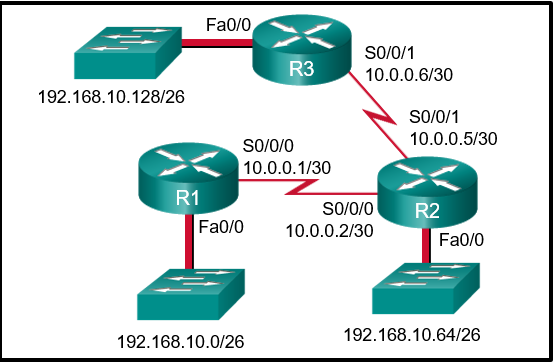
- send the packet out interface FastEthernet0/0
- send the packet out interface Serial0/0/1
- drop the packet
- send the packet out interface Serial0/0/0
19. An administrator issues the ipv6 route 2001:db8:acad:1::/32 gigabitethernet0/0 2001:db8:acad:6::1 100 command on a router. What administrative distance is assigned to this route?
- 0
- 1
- 32
- 100
20. Refer to the exhibit. Which default static route command would allow R1 to potentially reach all unknown networks on the Internet?
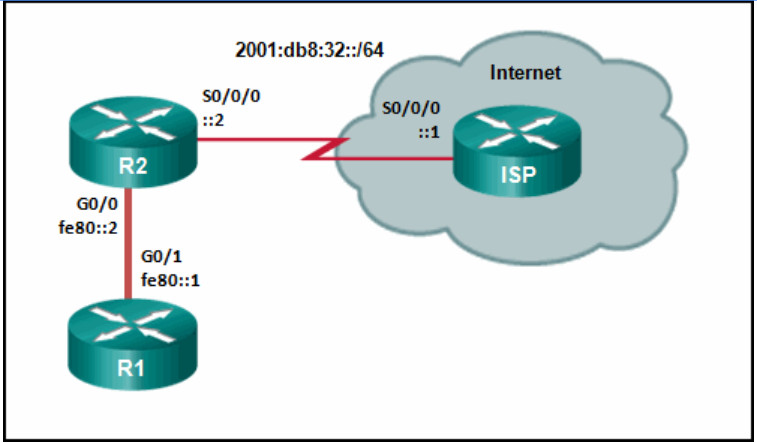
- R1(config)# ipv6 route 2001:db8:32::/64 G0/0
- R1(config)# ipv6 route ::/0 G0/0 fe80::2
- R1(config)# ipv6 route 2001:db8:32::/64 G0/1 fe80::2
- R1(config)# ipv6 route ::/0 G0/1 fe80::2
21. Refer to the exhibit. The network engineer for the company that is shown wants to use the primary ISP connection for all external connectivity. The backup ISP connection is used only if the primary ISP connection fails. Which set of commands would accomplish this goal?
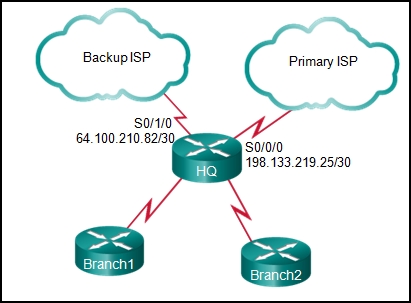
- ip route 0.0.0.0 0.0.0.0 s0/0/0
ip route 0.0.0.0 0.0.0.0 s0/1/0 - ip route 0.0.0.0 0.0.0.0 s0/0/0
ip route 0.0.0.0 0.0.0.0 s0/1/0 10 - ip route 198.133.219.24 255.255.255.252
ip route 64.100.210.80 255.255.255.252 10 - ip route 198.133.219.24 255.255.255.252
ip route 64.100.210.80 255.255.255.252
22. Refer to the exhibit. Which set of commands will configure static routes that will allow the Park and the Alta routers to a) forward packets to each LAN and b) direct all other traffic to the Internet?
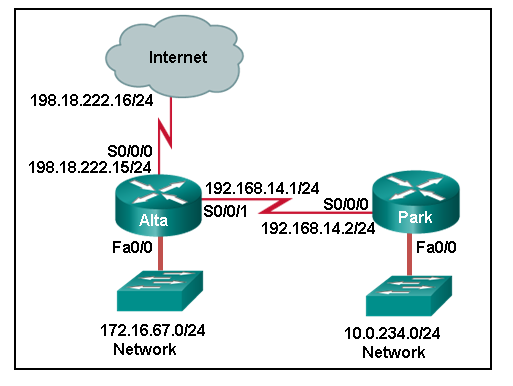
- Park(config)# ip route 0.0.0.0 0.0.0.0 192.168.14.1
Alta(config)# ip route 10.0.234.0 255.255.255.0 192.168.14.2
Alta(config)# ip route 0.0.0.0 0.0.0.0 s0/0/0 - Park(config)# ip route 0.0.0.0 0.0.0.0 192.168.14.1
Alta(config)# ip route 10.0.234.0 255.255.255.0 192.168.14.2
Alta(config)# ip route 198.18.222.0 255.255.255.255 s0/0/0 - Park(config)# ip route 172.16.67.0 255.255.255.0 192.168.14.1
Park(config)# ip route 0.0.0.0 0.0.0.0 192.168.14.1
Alta(config)# ip route 10.0.234.0 255.255.255.0 192.168.14.2 - Park(config)# ip route 172.16.67.0 255.255.255.0 192.168.14.1
Alta(config)# ip route 10.0.234.0 255.255.255.0 192.168.14.2
Alta(config)# ip route 0.0.0.0 0.0.0.0 s0/0/1
23. Refer to the exhibit. The small company shown uses static routing. Users on the R2 LAN have reported a problem with connectivity. What is the issue?
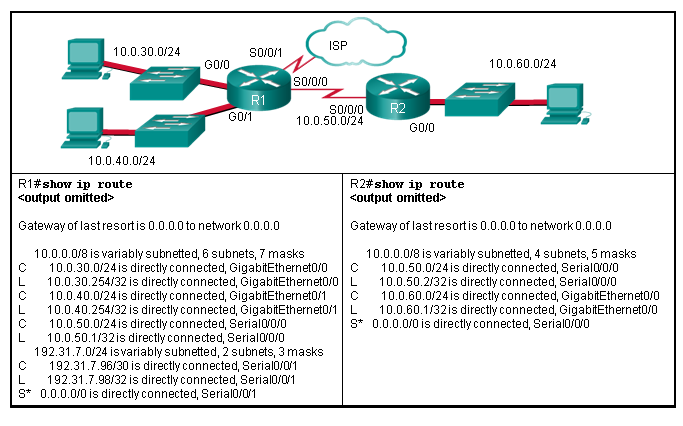
- R1 needs a static route to the R2 LAN.
- R2 needs a static route to the R1 LANs.
- R1 needs a default route to R2.
- R2 needs a static route to the Internet.
- R1 and R2 must use a dynamic routing protocol.
24. Refer to the exhibit. An administrator is attempting to install an IPv6 static route on router R1 to reach the network attached to router R2. After the static route command is entered, connectivity to the network is still failing. What error has been made in the static route configuration?
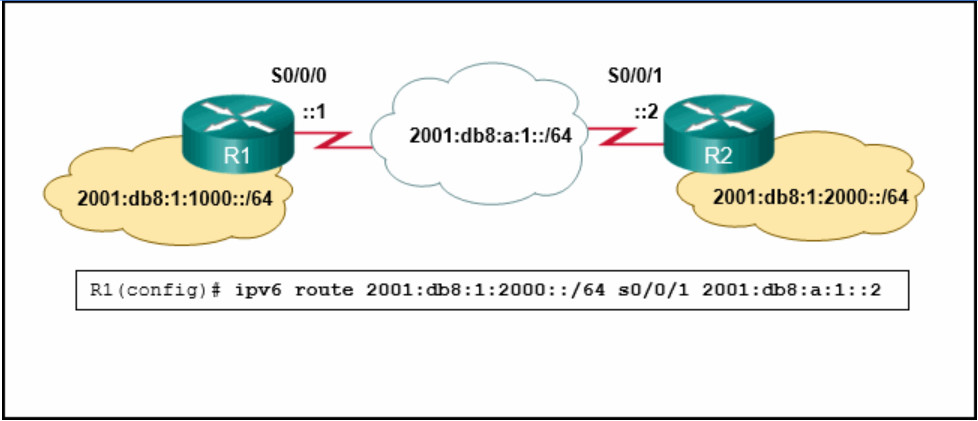
- The next hop address is incorrect.
- The interface is incorrect.
- The destination network is incorrect.
- The network prefix is incorrect.
25. Refer to the exhibit. How was the host route 2001:DB8:CAFE:4::1/128 installed in the routing table?
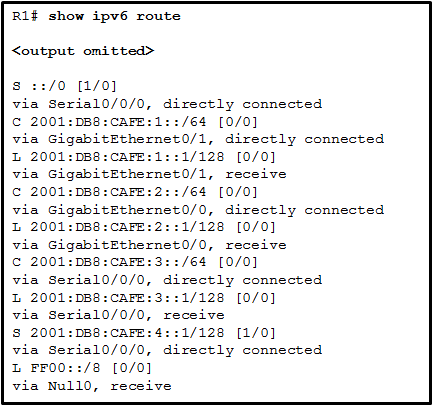
- The route was dynamically created by router R1.
- The route was dynamically learned from another router.
- The route was manually entered by an administrator.
- The route was automatically installed when an IP address was configured on an active interface.
26. Refer to the exhibit. HostA is attempting to contact ServerB. Which two statements correctly describe the addressing that HostA will generate in the process? (Choose two.)
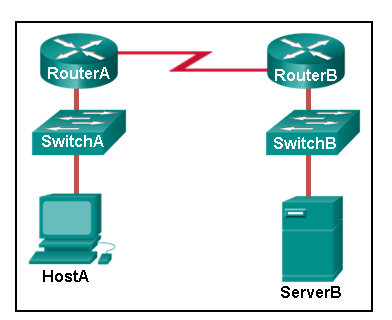
- A packet with the destination IP address of RouterA.
- A frame with the destination MAC address of SwitchA.
- A packet with the destination IP address of ServerB.
- A frame with the destination MAC address of RouterA.
- A frame with the destination MAC address of ServerB.
- A packet with the destination IP address of RouterB.
27. Refer to the exhibit. A ping from R1 to 10.1.1.2 is successful, but a ping from R1 to any address in the 192.168.2.0 network fails. What is the cause of this problem?
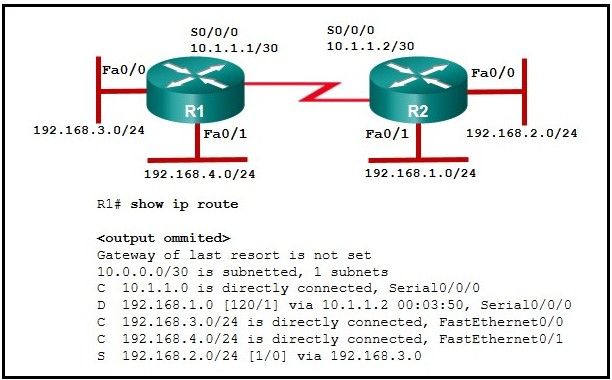
- There is no gateway of last resort at R1.
- The static route for 192.168.2.0 is incorrectly configured.
- A default route is not configured on R1.
- The serial interface between the two routers is down.
28. Refer to the exhibit. An administrator is attempting to install a default static route on router R1 to reach the Site B network on router R2. After entering the static route command, the route is still not showing up in the routing table of router R1. What is preventing the route from installing in the routing table?
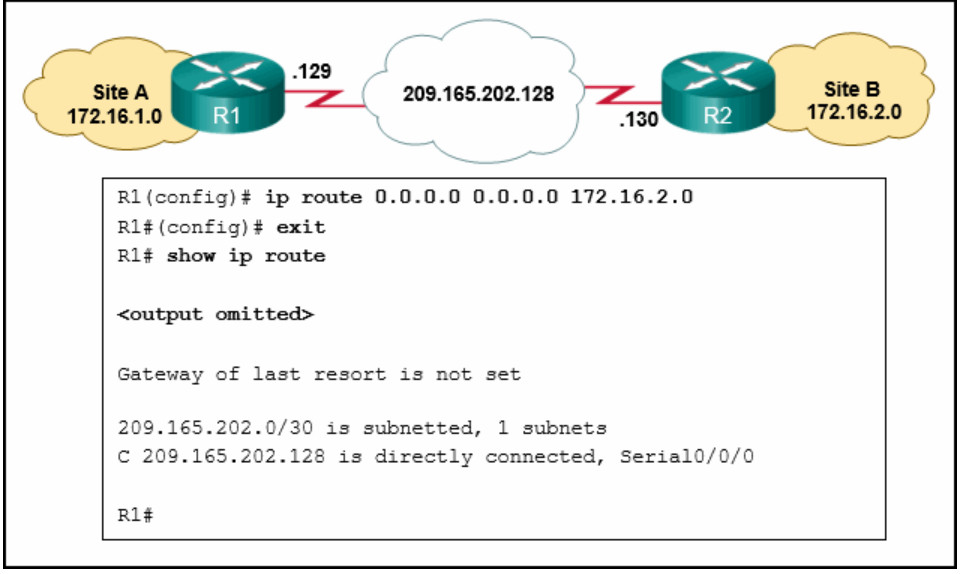
- The netmask is incorrect.
- The exit interface is missing.
- The next hop address is incorrect.
- The destination network is incorrect.
29. Refer to the exhibit. The Branch Router has an OSPF neighbor relationship with the HQ router over the 198.51.0.4/30 network. The 198.51.0.8/30 network link should serve as a backup when the OSPF link goes down. The floating static route command ip route 0.0.0.0 0.0.0.0 S0/1/1 100 was issued on Branch and now traffic is using the backup link even when the OSPF link is up and functioning. Which change should be made to the static route command so that traffic will only use the OSPF link when it is up?
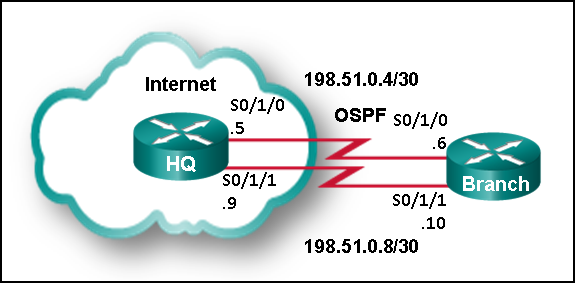
- Add the next hop neighbor address of 198.51.0.8.
- Change the administrative distance to 1.
- Change the destination network to 198.51.0.5.
- Change the administrative distance to 120.
30. What characteristic completes the following statement?
When an IPv6 static route is configured, the next-hop address can be ……
- a destination host route with a /128 prefix.
- the “show ipv6 route static” command.
- an IPv6 link-local address on the adjacent router.
- the interface type and interface number.
31. Gateway of last resort is not set.
172.19.115.0/26 is variously subnetted, 7 subnets, 3 masks
O 172.19.115.0/26 [110/10] via 172.19.39.1, 00:00:24, Serial0/0/0
O 172.19.115.64/26 [110/20] via 172.19.39.6, 00:00:56, Serial 0/0/1
O 172.19.115.128/26 [110/10] via 172.19.39.1, 00:00:24, Serial 0/0/0
C 172.19.115.192/27 is directly connected, GigabitEthernet0/0
L 172.19.115.193/27 is directly connected, GigabitEthernet0/0
C 172.19.115.224/27 is directly connected, GigabitEthernet0/1
L 172.19.115.225/27 is directly connected, GigabitEthernet0/1
172.19.39.0/24 is variably subnetted, 4 subnets, 2 masks
C 172.19.39.0/30 is directly connected, Serial0/0/0
L 172.19.39.2/32 is directly connected, Serial0/0/0
C 172.19.39.4/30 is directly connected, Serial0/0/1
L 172.19.39.5/32 is directly connected, Serial0/0/1
S 172.19.40.0/26 [1/0] via 172.19.39.1, 00:00:24, Serial0/0/0
R1#
Refer to the exhibit. Which interface will be the exit interface to forward a data packet that has the destination IP address 172.19.115.206?
- GigabitEthernet0/1
- None, the packet will be dropped.
- GigabitEthernet0/0
- Serial0/0/1
32. Refer to the exhibit. What routing solution will allow both PC A and PC B to access the Internet with the minimum amount of router CPU and network bandwidth utilization?
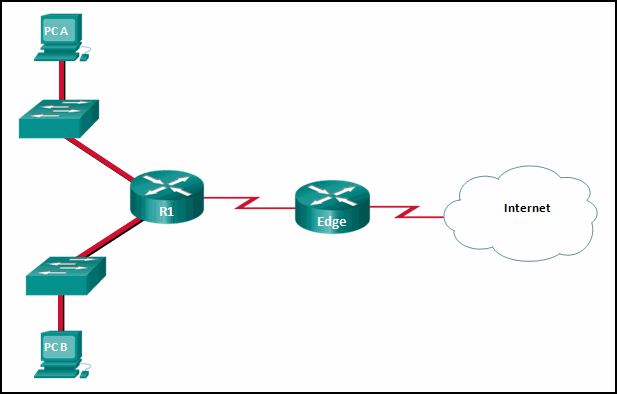
- Configure a dynamic routing protocol between R1 and Edge and advertise all routes.
- Configure a static route from R1 to Edge and a dynamic route from Edge to R1.
- Configure a static default route from R1 to Edge, a default route from Edge to the Internet, and a static route from Edge to R1.
- Configure a dynamic route from R1 to Edge and a static route from Edge to R1.
33. Refer to the exhibit. What would happen after the IT administrator enters the new static route?
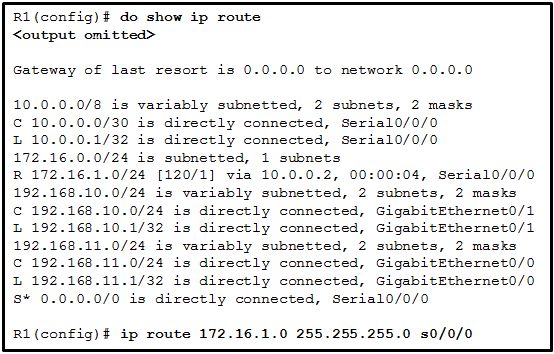
- The 172.16.1.0 static route would be entered into the running-config but not shown in the routing table.
- The 172.16.1.0 route learned from RIP would be replaced with the 172.16.1.0 static route.
- The 0.0.0.0 default route would be replaced with the 172.16.1.0 static route.
- The 172.16.1.0 static route is added to the existing routes in the routing table.
34. What two pieces of information are needed in a fully specified static route to eliminate recursive lookups? (Choose two.)
- the interface ID of the next-hop neighbor
- the interface ID exit interface
- the IP address of the exit interface
- the IP address of the next-hop neighbor
- the administrative distance for the destination network
35. Refer to the exhibit. Which command will properly configure an IPv6 static route on R2 that will allow traffic from PC2 to reach PC1 without any recursive lookups by router R2?
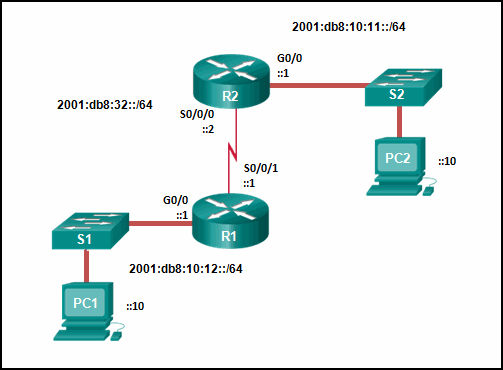
- R2(config)# ipv6 route ::/0 2001:db8:32::1
- R2(config)# ipv6 route 2001:db8:10:12::/64 S0/0/0
- R2(config)# ipv6 route 2001:db8:10:12::/64 2001:db8:32::1
- R2(config)# ipv6 route 2001:db8:10:12::/64 S0/0/1
36. Refer to the exhibit. Which static route would an IT technician enter to create a backup route to the 172.16.1.0 network that is only used if the primary RIP learned route fails?
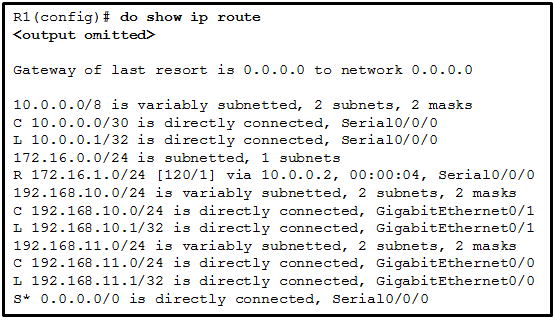
- ip route 172.16.1.0 255.255.255.0 s0/0/0
- ip route 172.16.1.0 255.255.255.0 s0/0/0 121
- ip route 172.16.1.0 255.255.255.0 s0/0/0 111
- ip route 172.16.1.0 255.255.255.0 s0/0/0 91
37. Open the PT Activity. Perform the tasks in the activity instructions and then answer the question.
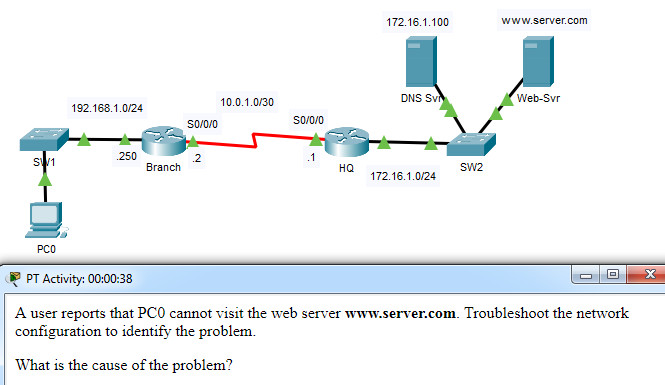
Modules 14 – 16: Routing Concepts and Configuration Exam
A user reports that PC0 cannot visit the web server www.server.com . Troubleshoot the network configuration to identify the problem.
What is the cause of the problem?
- The clock rate on one of the serial links is configured incorrectly.
- A serial interface on Branch is configured incorrectly.
- The DNS server address on PC0 is configured incorrectly.
- Routing between HQ and Branch is configured incorrectly.
38. Match the routing table entry to the corresponding function. (Not all options are used.)
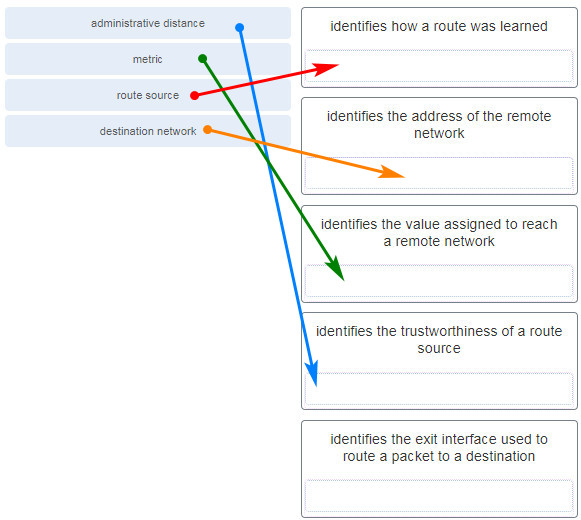
39. Refer to the exhibit. PC A sends a request to Server B. What IPv4 address is used in the destination field in the packet as the packet leaves PC A?

- 192.168.11.1
- 192.168.10.1
- 192.168.12.16
- 192.168.10.10
40. What does R1 use as the MAC address of the destination when constructing the frame that will go from R1 to Server B?
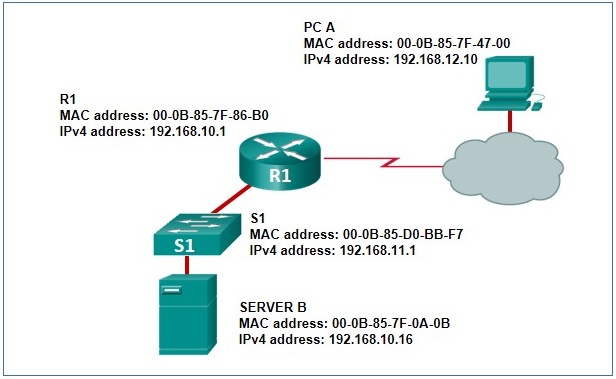
- If the destination MAC address that corresponds to the IPv4 address is not in the ARP cache, R1 sends an ARP request.
- R1 uses the destination MAC address of S1.
- The packet is encapsulated into a PPP frame, and R1 adds the PPP destination address to the frame.
- R1 leaves the field blank and forwards the data to the PC.
41. What route would have the lowest administrative distance?
- a route received through the OSPF routing protocol
- a directly connected network
- a static route
- a route received through the EIGRP routing protocol
42. What characteristic completes the following statement?
When an IPv6 static route is configured, as a backup route to a static route in the routing table, the “distance” command is used with ……
- the “show ipv6 route static” command.
- an administrative distance of 2.
- a destination host route with a /128 prefix.
- the interface type and interface number.
43. A router has used the OSPF protocol to learn a route to the 172.16.32.0/19 network. Which command will implement a backup floating static route to this network?
- ip route 172.16.0.0 255.255.224.0 S0/0/0 100
- ip route 172.16.0.0 255.255.240.0 S0/0/0 200
- ip route 172.16.32.0 255.255.224.0 S0/0/0 200
- ip route 172.16.32.0 255.255.0.0 S0/0/0 100
44. Consider the following command:
ip route 192.168.10.0 255.255.255.0 10.10.10.2 5
How would an administrator test this configuration?
- Delete the default gateway route on the router.
- Manually shut down the router interface used as a primary route.
- Ping from the 192.168.10.0 network to the 10.10.10.2 address.
- Ping any valid address on the 192.168.10.0/24 network.
45. Refer to the exhibit. Which type of IPv6 static route is configured in the exhibit?
![]()
- floating static route
- fully specified static route
- recursive static route
- directly attached static route
46. What characteristic completes the following statement?
When an IPv6 static route is configured, it is first necessary to configure ……
- the next-hop address of two different adjacent routers.
- the “ipv6 unicast-routing” command.
- an IPv6 link-local address on the adjacent router.
- an administrative distance of 2.
47. Gateway of last resort is not set.
172.18.109.0/26 is variously subnetted, 7 subnets, 3 masks O 172.18.109.0/26 [110/10] via 172.18.32.1, 00:00:24, Serial0/0/0 O 172.18.109.64/26 [110/20] via 172.18.32.6, 00:00:56, Serial 0/0/1 O 172.18.109.128/26 [110/10] via 172.18.32.1, 00:00:24, Serial 0/0/0 C 172.18.109.192/27 is directly connected, GigabitEthernet0/0 L 172.18.109.193/27 is directly connected, GigabitEthernet0/0 C 172.18.109.224/27 is directly connected, GigabitEthernet0/1 L 172.18.109.225/27 is directly connected, GigabitEthernet0/1 172.18.32.0/24 is variably subnetted, 4 subnets, 2 masks C 172.18.32.0/30 is directly connected, Serial0/0/0 L 172.18.32.2/32 is directly connected, Serial0/0/0 C 172.18.32.4/30 is directly connected, Serial0/0/1 L 172.18.32.5/32 is directly connected, Serial0/0/1 S 172.18.33.0/26 [1/0] via 172.18.32.1, 00:00:24, Serial0/0/0 R1#
Refer to the exhibit. Which interface will be the exit interface to forward a data packet that has the destination IP address 172.18.109.152?
- GigabitEthernet0/0
- GigabitEthernet0/1
- Serial0/0/0
- None, the packet will be dropped.
48. Refer to the exhibit. What will the router do with a packet that has a destination IP address of 192.168.12.227?
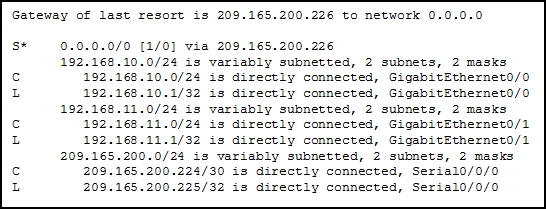
- Drop the packet.
- Send the packet out the GigabitEthernet0/0 interface.
- Send the packet out the Serial0/0/0 interface.
- Send the packet out the GigabitEthernet0/1 interface.
49. Consider the following command:
ip route 192.168.10.0 255.255.255.0 10.10.10.2 5
Which route would have to go down in order for this static route to appear in the routing table?
- a default route
- a static route to the 192.168.10.0/24 network
- an OSPF-learned route to the 192.168.10.0/24 network
- an EIGRP-learned route to the 192.168.10.0/24 network
50. What are two advantages of static routing over dynamic routing? (Choose two.)
- Static routing is more secure because it does not advertise over the network.
- Static routing scales well with expanding networks.
- Static routing requires very little knowledge of the network for correct implementation.
- Static routing uses fewer router resources than dynamic routing.
- Static routing is relatively easy to configure for large networks.
51. What characteristic completes the following statement?
When an IPv6 static route is configured, it is possible that the same IPv6 link-local address is used for …
- a destination host route with a /128 prefix.
- the “ipv6 unicast-routing” command.
- the next-hop address of two different adjacent routers.
- an administrative distance of 2.
52. A network administrator configures the interface fa0/0 on the router R1 with the command ip address 172.16.1.254 255.255.255.0. However, when the administrator issues the command show ip route, the routing table does not show the directly connected network. What is the possible cause of the problem?
- The subnet mask is incorrect for the IPv4 address.
- The configuration needs to be saved first.
- The interface fa0/0 has not been activated.
- No packets with a destination network of 172.16.1.0 have been sent to R1.
53. Refer to the exhibit. What command would be used to configure a static route on R1 so that traffic from both LANs can reach the 2001:db8:1:4::/64 remote network?
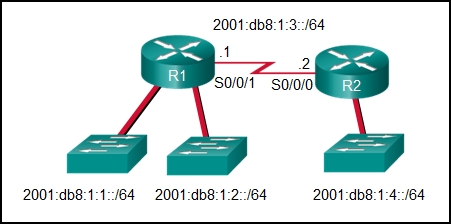
- ipv6 route 2001:db8:1:4::/64 2001:db8:1:3::1
- ipv6 route 2001:db8:1::/65 2001:db8:1:3::1
- ipv6 route ::/0 serial0/0/0
- ipv6 route 2001:db8:1:4::/64 2001:db8:1:3::2
54. Refer to the exhibit. What two commands will change the next-hop address for the 10.0.0.0/8 network from 172.16.40.2 to 192.168.1.2? (Choose two.)
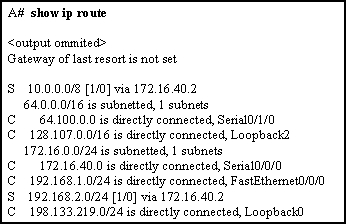
- A(config)# ip route 10.0.0.0 255.0.0.0 192.168.1.2
- A(config)# ip route 10.0.0.0 255.0.0.0 s0/0/0
- A(config)# no ip address 10.0.0.1 255.0.0.0 172.16.40.2
- A(config)# no network 10.0.0.0 255.0.0.0 172.16.40.2
- A(config)# no ip route 10.0.0.0 255.0.0.0 172.16.40.2
55. Refer to the exhibit. Which interface will be the exit interface to forward a data packet that has the destination IP address 192.168.139.244?
Gateway of last resort is not set. 192.168.139.0/26 is variously subnetted, 7 subnets, 3 masks O 192.168.139.0/26 [110/10] via 192.168.70.1, 00:00:24, Serial0/0/0 O 192.168.139.64/26 [110/20] via 192.168.70.6, 00:00:56, Serial 0/0/1 O 192.168.139.128/26 [110/10] via 192.168.70.1, 00:00:24, Serial 0/0/0 C 192.168.139.192/27 is directly connected, GigabitEthernet0/0 L 192.168.139.193/27 is directly connected, GigabitEthernet0/0 C 192.168.139.224/27 is directly connected, GigabitEthernet0/1 L 192.168.139.225/27 is directly connected, GigabitEthernet0/1 192.168.70.0/24 is variably subnetted, 4 subnets, 2 masks C 192.168.70.0/30 is directly connected, Serial0/0/0 L 192.168.70.2/32 is directly connected, Serial0/0/0 C 192.168.70.4/30 is directly connected, Serial0/0/1 L 192.168.70.5/32 is directly connected, Serial0/0/1 S 192.168.71.0/26 [1/0] via 192.168.70.1, 00:00:24, Serial0/0/0 R1#
- GigabitEthernet0/1
- None, the packet will be dropped.
- Serial0/0/1
- GigabitEthernet0/0
56. What characteristic completes the following statement?
When an IPv6 static route is configured, a fully-specified configuration should be used with …
- ::/0.
- the “ipv6 unicast-routing” command.
- the next-hop address of two different adjacent routers.
- a directly connected multiaccess network.
57. Refer to the exhibit. Which interface will be the exit interface to forward a data packet that has the destination IP address 192.168.71.52?
Gateway of last resort is not set. 192.168.139.0/26 is variously subnetted, 7 subnets, 3 masks O 192.168.139.0/26 [110/10] via 192.168.70.1, 00:00:24, Serial0/0/0 O 192.168.139.64/26 [110/20] via 192.168.70.6, 00:00:56, Serial 0/0/1 O 192.168.139.128/26 [110/10] via 192.168.70.1, 00:00:24, Serial 0/0/0 C 192.168.139.192/27 is directly connected, GigabitEthernet0/0 L 192.168.139.193/27 is directly connected, GigabitEthernet0/0 C 192.168.139.224/27 is directly connected, GigabitEthernet0/1 L 192.168.139.225/27 is directly connected, GigabitEthernet0/1 192.168.70.0/24 is variably subnetted, 4 subnets, 2 masks C 192.168.70.0/30 is directly connected, Serial0/0/0 L 192.168.70.2/32 is directly connected, Serial0/0/0 C 192.168.70.4/30 is directly connected, Serial0/0/1 L 192.168.70.5/32 is directly connected, Serial0/0/1 S 192.168.71.0/26 [1/0] via 192.168.70.1, 00:00:24, Serial0/0/0 R1#
- The packet will take the gateway of last resort.
- GigabitEthernet0/1
- Serial0/0/0
- None, the packet will be dropped.
58. What characteristic completes the following statement?
When an IPv6 static route is configured, the installation of the route can be verified with ……
- a destination host route with a /128 prefix.
- the interface type and interface number.
- the “show ipv6 route static” command.
- an administrative distance of 2.
59. Refer to the exhibit. Which interface will be the exit interface to forward a data packet that has the destination IP address 10.55.99.78?
Gateway of last resort is not set. 10.55.99.0/26 is variously subnetted, 7 subnets, 3 masks O 10.55.99.0/26 [110/10] via 10.55.18.1, 00:00:24, Serial0/0/0 O 10.55.99.64/26 [110/20] via 10.55.18.6, 00:00:56, Serial 0/0/1 O 10.55.99.128/26 [110/10] via 10.55.18.1, 00:00:24, Serial 0/0/0 C 10.55.99.192/27 is directly connected, GigabitEthernet0/0 L 10.55.99.193/27 is directly connected, GigabitEthernet0/0 C 10.55.99.224/27 is directly connected, GigabitEthernet0/1 L 10.55.99.225/27 is directly connected, GigabitEthernet0/1 10.55.18.0/24 is variably subnetted, 4 subnets, 2 masks C 10.55.18.0/30 is directly connected, Serial0/0/0 L 10.55.18.2/32 is directly connected, Serial0/0/0 C 10.55.18.4/30 is directly connected, Serial0/0/1 L 10.55.18.5/32 is directly connected, Serial0/0/1 S 10.55.19.0/26 [1/0] via 10.55.18.1, 00:00:24, Serial0/0/0 R1#
- None, the packet will be dropped.
- GigabitEthernet0/0
- GigabitEthernet0/1
- Serial0/0/1
60. A network administrator configures the interface fa0/0 on the router R1 with the command ip address 172.16.1.254 255.255.255.0 . However, when the administrator issues the command show ip route , the routing table does not show the directly connected network. What is the possible cause of the problem?
- The subnet mask is incorrect for the IPv4 address.
- No packets with a destination network of 172.16.1.0 have been sent to R1.
- The configuration needs to be saved first.
- The interface fa0/0 has not been activated.
61. Refer to the exhibit. Which interface will be the exit interface to forward a data packet that has the destination IP address 10.3.86.2?
Gateway of last resort is not set. 10.3.86.0/26 is variously subnetted, 7 subnets, 3 masks O 10.3.86.0/26 [110/10] via 10.3.2.1, 00:00:24, Serial0/0/0 O 10.3.86.64/26 [110/20] via 10.3.2.6, 00:00:56, Serial 0/0/1 O 10.3.86.128/26 [110/10] via 10.3.2.1, 00:00:24, Serial 0/0/0 C 10.3.86.192/27 is directly connected, GigabitEthernet0/0 L 10.3.86.193/27 is directly connected, GigabitEthernet0/0 C 10.3.86.224/27 is directly connected, GigabitEthernet0/1 L 10.3.86.225/27 is directly connected, GigabitEthernet0/1 10.3.2.0/24 is variably subnetted, 4 subnets, 2 masks C 10.3.2.0/30 is directly connected, Serial0/0/0 L 10.3.2.2/32 is directly connected, Serial0/0/0 C 10.3.2.4/30 is directly connected, Serial0/0/1 L 10.3.2.5/32 is directly connected, Serial0/0/1 S 10.3.3.0/26 [1/0] via 10.3.2.1, 00:00:24, Serial0/0/0 R1#
- GigabitEthernet0/1
- Serial0/0/1
- GigabitEthernet0/0
- Serial0/0/0
62. Match the characteristic to the corresponding type of routing. (Not all options are used.)


63. Refer to the exhibit. Which interface will be the exit interface to forward a data packet that has the destination IP address 172.25.128.244?
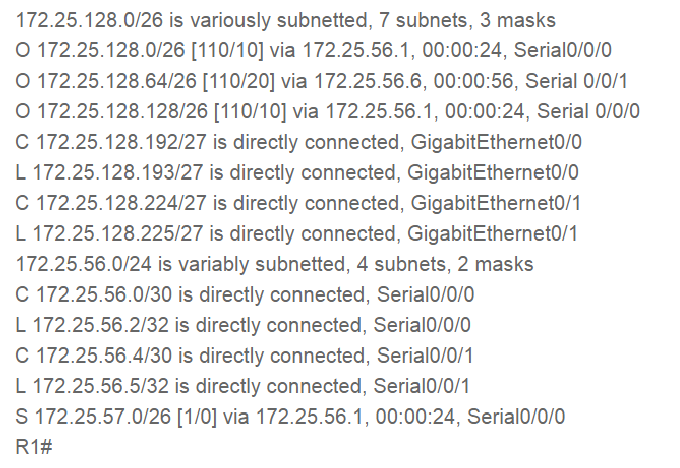
- GigabitEthernet0/0
- GigabitEthernet0/1
- None, the packet will be dropped.
- Serial0/0/1
64. Ipv6 route 2001:0DB8::/32 2001:0DB8:3000::1
Which static route is configured here?
- Floating static
- Recursive static
- Directly attached static
- Fully specified static
Consider the following command:
ip route 192.168.10.0 255.255.255.0 10.10.10.2 5
What does the 5 at the end of the command signify?
The correct anwer is maximum number of hops to the 192.168.10.0/24 network
This exam is so boring
easy A+ <3
12/8/2020
What characteristic completes the following statement?
When an IPv6 static route is configured, it is possible that the same IPv6 link-local address is used for ……
What characteristic completes the following statement?
When an IPv6 static route is configured, the installation of the route can be verified with ….
Q. Ipv6 route 2001:0DB8::/32 2001:0DB8:3000::1
Which static route is configured here?
A. Floating static
B. Recursive static
C. Directly attached static
D. Fully specified static
Gateway of last resort is not set. 172.25.128.0/26 is variously subnetted, 7 subnets, 3 masks O 172.25.128.0/26 [110/10] via 172.25.56.1, 00:00:24, Serial0/0/0 O 172.25.128.64/26 [110/20] via 172.25.56.6, 00:00:56, Serial 0/0/1 O 172.25.128.128/26 [110/10] via 172.25.56.1, 00:00:24, Serial 0/0/0 C 172.25.128.192/27 is directly connected, GigabitEthernet0/0 L 172.25.128.193/27 is directly connected, GigabitEthernet0/0 C 172.25.128.224/27 is directly connected, GigabitEthernet0/1 L 172.25.128.225/27 is directly connected, GigabitEthernet0/1 172.25.56.0/24 is variably subnetted, 4 subnets, 2 masks C 172.25.56.0/30 is directly connected, Serial0/0/0 L 172.25.56.2/32 is directly connected, Serial0/0/0 C 172.25.56.4/30 is directly connected, Serial0/0/1 L 172.25.56.5/32 is directly connected, Serial0/0/1 S 172.25.57.0/26 [1/0] via 172.25.56.1, 00:00:24,… Read more »
30. What characteristic completes the following statement?
When an IPv6 static route is configured, the next-hop address can be ……
The answer “an IPv6 link-local address on the adjacent router” is incorrect. Cisco IOS will complain and require an exit interface id to be specified. So the correct answer should be (D) the interface type and interface number
this question is not here its a new question
Q# What characteristic completes the following statement?
When an IPv6 static route is configured, it is first necessary to configure ……
.an IPv6 link-local address on the adjacent router.
.an administrative distance of 2.
.the next-hop address of two different adjacent routers.
.the “ipv6 unicast-routing” command.
A new question:
Gateway of the last resort is not set.
https://ibb.co/pvnTPMV
Refer to the exhibit. Which interface will be the exit interface to forward a data packet that has the destination IP address 172.25.128.244?
GigabitEhternet0/1
GigabitEthernet0/0
None, the packet will be dropped.
Serial0/0/1
The correct answer is: GigabitEthernet0/1
(I hope you can see the image)
a new question is the folowing:
Gateway of the last resort is not set.
more 2 questions: A) What are two advantages of static routing over dynamic routing? (Choose two.) a)Static routing scales well with expanding networks. b)Static routing uses fewer router resources than dynamic routing. c)Static routing is more secure because it does not advertise over the network. d)Static routing requires very little knowledge of the network for correct implementation. e)Static routing is relatively easy to configure for large networks. B) When would it be more beneficial to use a dynamic routing protocol instead of static routing? a)on a network where there is a lot of topology changes b)in an organization where routers… Read more »
What characteristic completes the following statement?
When an IPv6 static route is configured, the next-hop address can be ……
a. a destination host route with a /128 prefix.
b. the “show ipv6 route static” command.
c. an IPv6 link-local address on the adjacent router.
the interface type and interface number.
Gateway of last resort is not set. 172.25.128.0/26 is variously subnetted, 7 subnets, 3 masks O 172.25.128.0/26 [110/10] via 172.25.56.1, 00:00:24, Serial0/0/0 O 172.25.128.64/26 [110/20] via 172.25.56.6, 00:00:56, Serial 0/0/1 O 172.25.128.128/26 [110/10] via 172.25.56.1, 00:00:24, Serial 0/0/0 C 172.25.128.192/27 is directly connected, GigabitEthernet0/0 L 172.25.128.193/27 is directly connected, GigabitEthernet0/0 C 172.25.128.224/27 is directly connected, GigabitEthernet0/1 L 172.25.128.225/27 is directly connected, GigabitEthernet0/1 172.25.56.0/24 is variably subnetted, 4 subnets, 2 masks C 172.25.56.0/30 is directly connected, Serial0/0/0 L 172.25.56.2/32 is directly connected, Serial0/0/0 C 172.25.56.4/30 is directly connected, Serial0/0/1 L 172.25.56.5/32 is directly connected, Serial0/0/1 S 172.25.57.0/26 [1/0] via 172.25.56.1, 00:00:24,… Read more »
A network administrator configures the interface fa0/0 on the router R1 with the command ip address 172.16.1.254 255.255.255.0 . However, when the administrator issues the command show ip route , the routing table does not show the directly connected network. What is the possible cause of the problem?
The subnet mask is incorrect for the IPv4 address.
No packets with a destination network of 172.16.1.0 have been sent to R1.
The interface fa0/0 has not been activated.
The configuration needs to be saved first.
Please add the question:
What characteristic completes the following statement?
When an IPv6 static route is configured, as a backup route to a static route in the routing table, the “distance” command is used with ……
the interface type and interface number.
an administrative distance of 2.
a destination host route with a /128 prefix.
the “show ipv6 route static” command.
Hi,
Can anyone advise if these questions enough to pass CCNA 200-301 or do i need to buy dumps?
TIA
What characteristic completes the following statement?
When an IPv6 static route is configured, a fully-specified configuration should be used with ……
::/0.
the “ipv6 unicast-routing” command.
the next-hop address of two different adjacent routers.
a directly connected multiaccess network. (correct)
a
What characteristic completes the following statement?
When an IPv6 static route is configured, a fully-specified configuration should be used with ……
a directly connected multiaccess network.
::/0.
the next-hop address of two different adjacent routers.
the “ipv6 unicast-routing” command.
Open the PT Activity. Perform the tasks in the activity instructions and then answer the question.
A user reports that PC0 cannot visit the web server http://www.server.com. Troubleshoot the network configuration to identify the problem.
What is the cause of the problem?
The DNS server address on PC0 is configured incorrectly.
A serial interface on Branch is configured incorrectly.
Correct Response
Routing between HQ and Branch is configured incorrectly.
The clock rate on one of the serial links is configured incorrectly.
Match the characteristic to the corresponding type of routing. (Not all options are used.)
left side:
typically used on stub networks
not suitable for topologies where more than one router is required.
new networks are added automatically to the routing table
best choice for large networks
less routing overhead
right side:
static routing (with 2 target windows)
dynamic routing (with 2 target windows)
What characteristic completes the following statement?
When an IPv6 static route is configured, the installation of the route can be verified with ……
a destination host route with a /128 prefix.
an administrative distance of 2.
the “show ipv6 route static” command.
the interface type and interface number.
What characteristic completes the following statement?
When an IPv6 static route is configured, as a backup route to a static route in the routing table, the “distance” command is used with ……
a destination host route with a /128 prefix.
the interface type and interface number.
an administrative distance of 2.
the “show ipv6 route static” command.
A network administrator configures the interface fa0/0 on the router R1 with the command ip address 172.16.1.254 255.255.255.0 . However, when the administrator issues the command show ip route , the routing table does not show the directly connected network. What is the possible cause of the problem?
-No packets with a destination network of 172.16.1.0 have been sent to R1.
-The subnet mask is incorrect for the IPv4 address.
-The interface fa0/0 has not been activated.
-The configuration needs to be saved first.
Consider the following command:
ip route 192.168.10.0 255.255.255.0 10.10.10.2 5
Which route would have to go down in order for this static route to appear in the routing table?
an EIGRP-learned route to the 192.168.10.0/24 network
a default route
an OSPF-learned route to the 192.168.10.0/24 network
a static route to the 192.168.10.0/24 network
What characteristic completes the following statement?
When an IPv6 static route is configured, it is possible that the same IPv6 link-local address is used for ……
a destination host route with a /128 prefix.
the “ipv6 unicast-routing” command.
the next-hop address of two different adjacent routers.
an administrative distance of 2.
What are two advantages of static routing over dynamic routing? (Choose two.)
Static routing scales well with expanding networks.
Static routing requires very little knowledge of the network for correct implementation.
Static routing is more secure because it does not advertise over the network.
Static routing is relatively easy to configure for large networks.
Static routing uses fewer router resources than dynamic routing.